My journey began as I flew to Madagascar, arriving in Antananarivo in the afternoon. I was welcomed with a fresh green coconut by the roadside. As I savoured the sweet coconut water and watched farmers gather duckweed from shallow lakes, a calming shift in pace and environment washed over me. The warmth of the air and the wide, open landscape was a far cry from the hurried, crowded streets of London. Here, life seemed to move as dictated by nature and necessity.
After a brief rest and catching up with the two brothers who make up the administration team, together we hit the road, reaching Antsirabe by evening. A substantial highland town and home to my cousin, where over dinner we reminisced about family and shared updates on our respective lives. It is also where our lapidary workshop is based, and we planned to visit it on our return journey.
The next day began in the cool, faint light of a 5 a.m. start. Ahead of us lay a fifteen-hour drive, winding through farming valleys and rolling hills, gradually giving way to barren, rocky expanses. Past mountains that seemed to flow and melt under the sun, their surreal appearance reflecting the intensity of the day’s heat. In one village, a sudden storm caused a flash flood, sweeping away the stalls of street traders too slow to react. By late afternoon, we descended onto vast grassy plains. As the day faded, flashes of lightning lit the sky, followed by wildfires that burned like torches in the distance.
It was in darkness that we finally arrived at Isalo National Park. Riddled with crumbling canyons and rocky pillars, this otherworldly region draws adventurous tourists. To cater to them, a handful of hotels offer safety and reliable amenities. We chose one as our base of operations, even though it was still a three-hour drive to the village, requiring another early start the following morning.
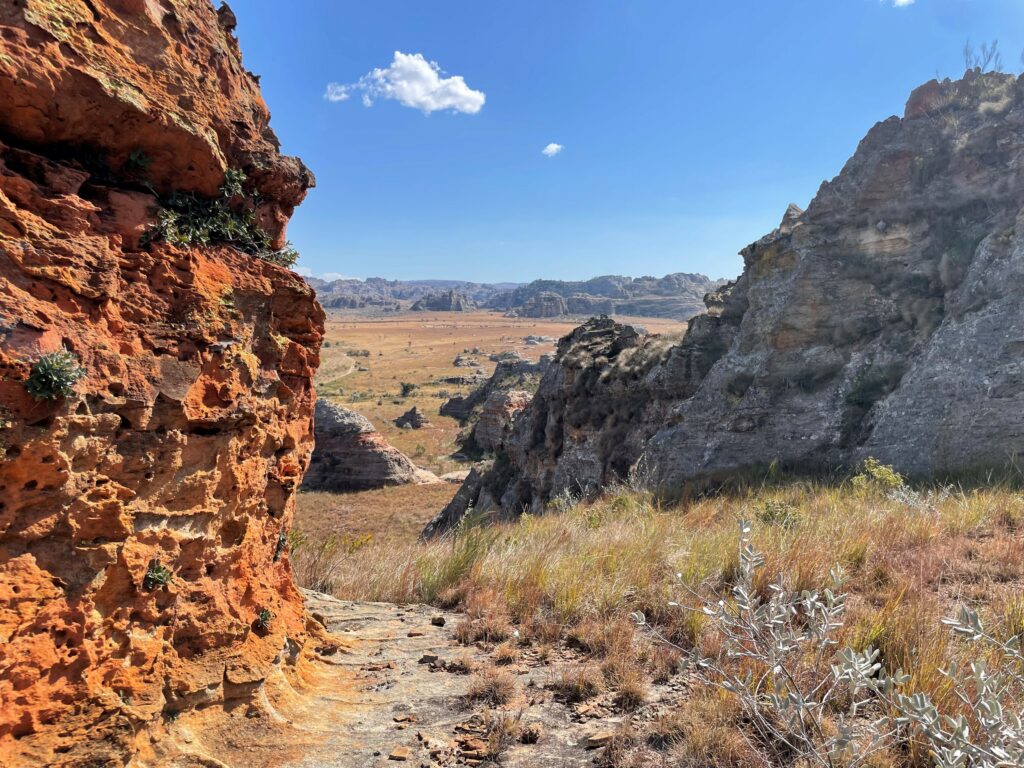
The canyons of Isalo
This was my first visit to the mining village, which turned out to be a predominantly agricultural community. Dust hung in the air, and rice lay spread out to dry in between the numerous small, red buildings. Compared to the previous village I had visited, it seemed more organised, with most residents busily engaged in some form of work. I noted the quality of the thatched roofs, obviously constructed with skill and care.
My first stop was the village leader’s house, where we had recently installed a concrete floor. The house itself was small, with three modest rooms, but the new flooring was well-made and should improve their living conditions.
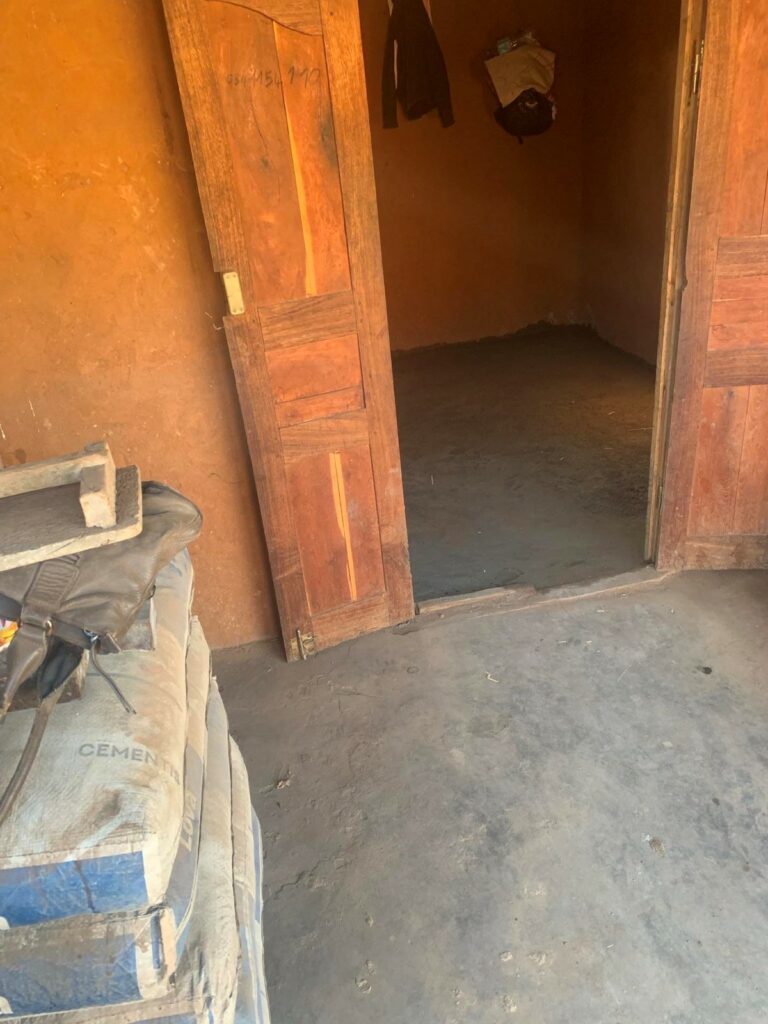
The only concrete floor in the village
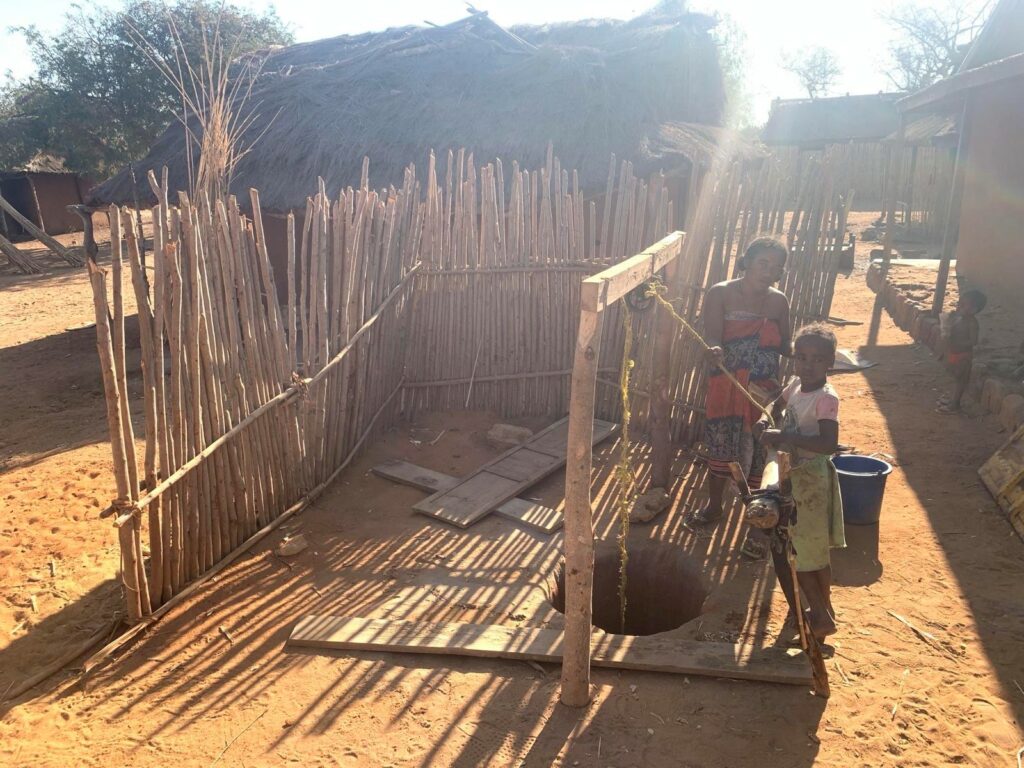
The well under construction
Next, I inspected the well we had constructed. It was narrow and approximately 30 meters deep, with some water visible at the bottom. However, there was already talk of digging deeper to ensure a more reliable water supply. Nearby was the accommodation for the mining operations team; a small hut rented from the village leader. The entire team slept in one room that also housed a table, a chair, and a solar powered battery for charging torches and phones.
A short drive into the surrounding scrub brought us to the mining site. The landscape here is arid, with dusty reddish ground punctuated by scattered trees, bushes, and cacti. At this village, the gravel layer is remarkably shallow, with stones typically found at a depth of three meters. Many other sites require digging down 25 to 30 meters to reach the gravel, after which miners excavate horizontal shafts. This process can be extremely dangerous, with the risk of tunnel collapses a grim reality.
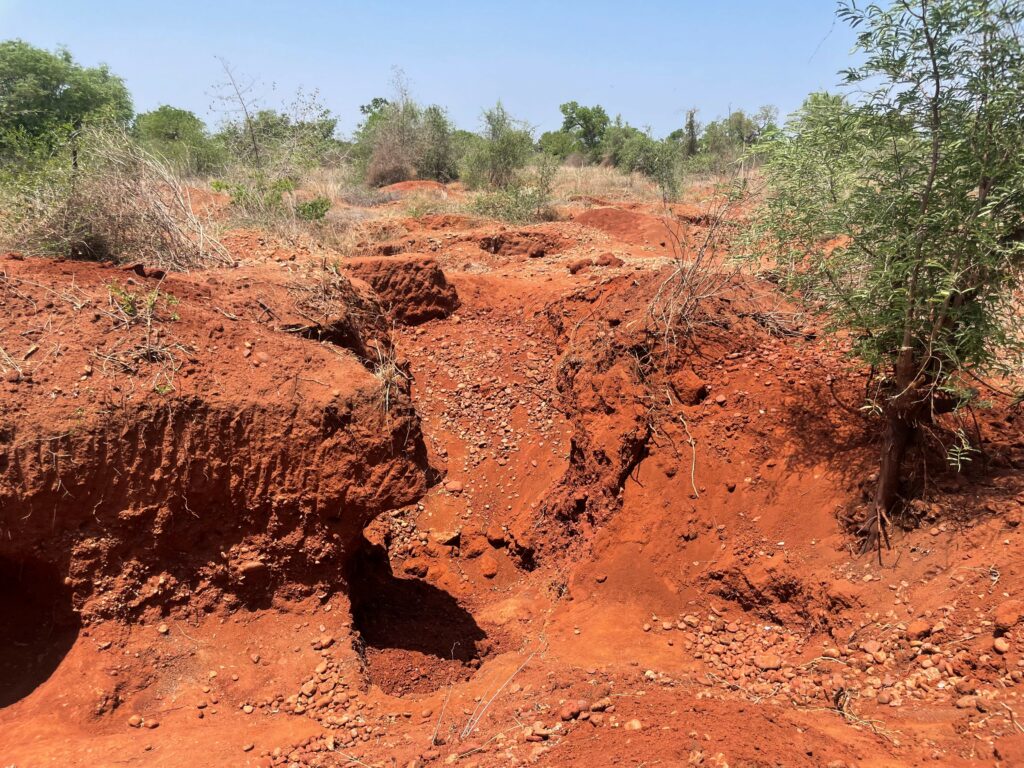
Open pit mining
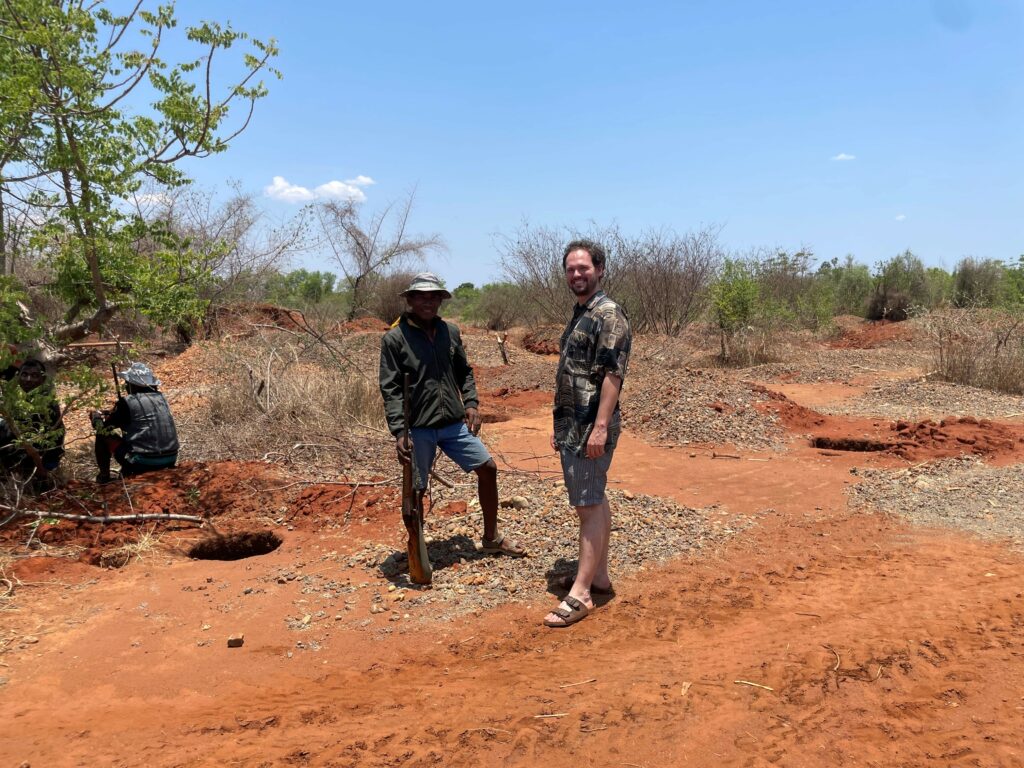
Exploration holes
I was relieved our team was working at a site with such shallow depths, where the risk to miners’ lives was significantly reduced. The need for complex safety measures, difficult to implement in such remote conditions, was minimized.
The process is simple in theory: pick a spot, dig until you hit the gravel layer, then sieve through. If you find any sapphires, it’s likely a promising area. The next step is to dig a few more test holes nearby. If gems are found in any of these, there’s a good chance the space in between will also yield stones. At this point, the main pit is excavated and lots of incredible sapphires are uncovered. At least that is the hope.
These shallow pits are known as ‘jaguars,’ though the origin of this name remains a curious mystery. Most of our production has come from these pits, which are relatively safe compared to deeper shafts. However, I noticed instances of tunnelling under the edges, creating precarious overhangs that could be hazardous. Addressing this will be necessary to keep operations safe and sustainable.
I spent some time exploring the pits, it was possible to see the layers of different sized pebbles clearly, a record of the ebb and flow of long-lost rivers. Glistening quartzes drew me in, and it was easy to lose time searching for interesting stones.
Our next stop was the sieving area at the local river. Gravel from the mining site is packed into sacks, loaded onto a truck, and transported here for washing and sorting. The scene was lively with people washing clothes and themselves, children joyfully splashing in the water, and a few bystanders idly observing. Among the crowd was a woman who had started a small business cooking food for the workers. I learned that, during busier times, the river had been a hub of commerce, with small businesses selling food, clothing, and other necessities to the miners. Amidst the activity, the workers meticulously washed and sorted gravel from the mining site, focused on uncovering gemstones.
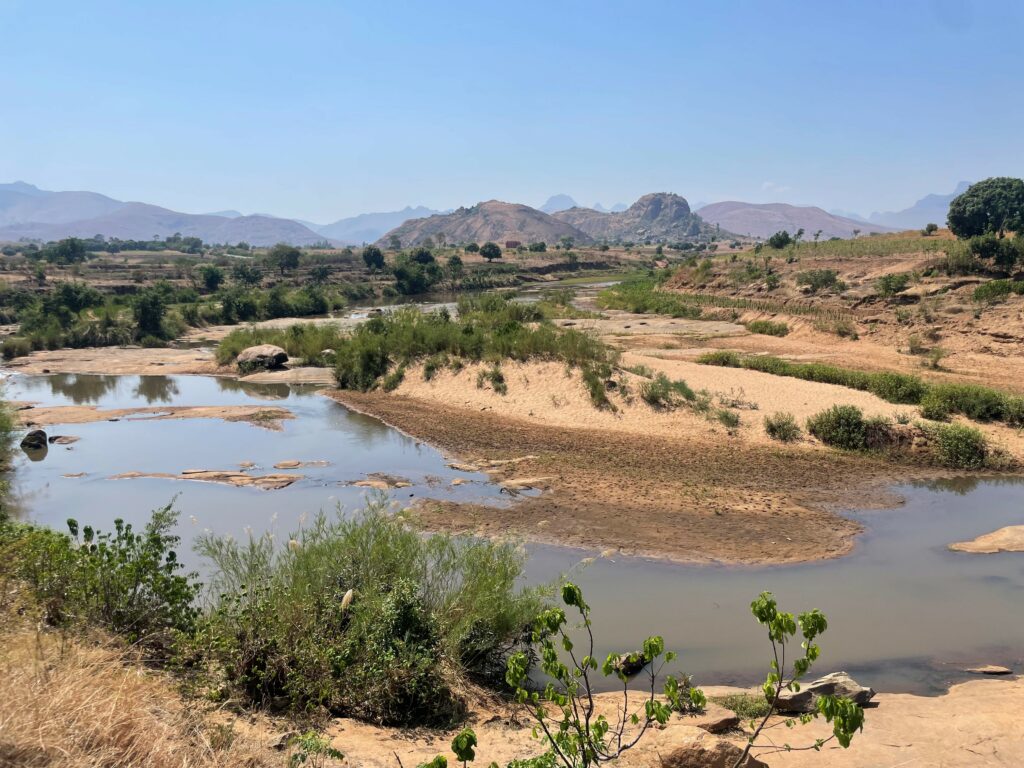
View of the river
A reminder of competition loomed nearby: a tractor belonging to a rival operator stood in the river. I was told that during the period when we were unable to mine, they had worked our abandoned site and uncovered some significant stones, including an alexandrite and a large pink sapphire; both much more valuable than anything we’ve found so far. This news was frustrating, but it also offered hope, affirming that the site still held potential for remarkable discoveries.
The village chief was also at the river, accompanied by a retinue, some of whom were armed. We ended up sitting under a cliff at the river’s edge for a meeting. Much of the discussion was conducted in Malagasy, spoken in a dialect even the brothers struggled to follow. Thankfully, two young Malagasy men introduced themselves as translators, having been brought in by the chief and, unexpectedly, the father, who also turned up despite being asked to leave what should have been a private meeting.
The chief presented his demands: a school, a hospital, and a motorbike. This was more than a request; it was a test, forcing us to navigate the fine line between support and compliance. The father enthusiastically endorsed these demands, increasing the pressure further. His insistent behaviour left little doubt that he was the one orchestrating the situation. The air became heavy, the world shrinking to the narrow, rocky path between the river and cliff. Everyone was still. I tried to explain that we couldn’t fund all these projects immediately. I suggested that he prioritize one, so we could create a feasible plan. The weight of their stares bore down on me, their expressionless faces revealing nothing. After a moment to translate, the chief responded by insisting on the motorbike as the priority. Offering to take cash to purchase it himself if we were unable to source one…
The request caught me off guard. Of course, I couldn’t simply buy him a motorbike! Not only would it be impossible to justify, but it would clearly fall into the category of bribery; a precedent I was determined not to set. Despite my unease, heightened by the rifles causally held in view, it was crucial not to show weakness. We asked for a moment to step away and discuss. Back at the car, our mining manager joined us to help unpack the situation. The local politics were complex, and much of the cultural context was difficult for me to fully grasp, adding to the challenge of navigating this delicate negotiation.
Our mining manager explained that this situation was partly a show of strength and partly the result of the father’s influence. He had been spreading rumours that we had earned far more from the mining operations than we claimed. This was all a negotiation tactic; they were demanding significantly more than they realistically expected to receive. After some discussion, we decided that the best course of action would be to meet with the village leader privately, away from the volatile atmosphere, to attempt a more constructive conversation.
After sitting down with the village leader for a long chat, he seemed much more at ease and amicable. We agreed to pay him a small sum of money and promised to continue supporting the village. In return, he assured us we could continue mining and have access to village amenities and security. He also expressed his gratitude for the work we had done so far, saying he was happy to have us in the community. Overall, it was a positive outcome and a great relief.
However, the father remained a disquieting presence. Upon our return, he approached me, requesting a private meeting with his translators. He wanted to discuss working together and selling his remaining production. I refused, insisting that any collaboration must be done through and with the approval of the brothers and his son. A brief meeting between them followed but did not go well, and the father returned, once again insisting on a private audience with me. At that point, we decided it was best to end the day and leave before dark, as the situation still felt capricious.
We arrived back at the hotel just as night fell, reflecting on an eventful and unexpected day. While the brothers were perturbed by the ongoing drama and political manoeuvring, I found myself energized and eager to return to the mining site. However, we knew we couldn’t proceed until the situation with the father was resolved. We made plans to hold a meeting with him the following morning.
The meeting took place under the shade of a tamarind tree, a quiet spot teeming with life. Lizards darted about, and we spotted a snake hunting them as we arrived. We sat on the ground in a circle and began what turned into a serious yet civil discussion. Each person was given their turn to speak without interruption. The father spoke at length, with the entire conversation conducted in Malagasy. What started as a negotiation gradually morphed into something resembling a family therapy session, stretching on for a couple of hours.
My patience was tested as the discussion wore on, and I found myself frequently distracted by the lizards scurrying all around us, engaged in an endless game of tag. Despite this, I could see that my presence and occasional input were having a positive effect, so I chose to endure. Eventually, we reached a reconciliation, allowing long-suppressed feelings to surface and find space to breathe. In the end we agreed to buy a few of his stones, which would enable him to settle his debts and leave the village. A particularly poignant moment came when his wife, speaking to him on the phone, broke down in tears upon hearing that he would finally be coming home. I watched the fight drain from him, his stubborn resilience giving way to a quiet acceptance. Though the tension lingered, it was beginning to unravel.
Much of the day was consumed by the meeting, but it had been time well spent. With the main issue finally resolved, we returned to the river to examine some of the day’s find. Among the discoveries were a few small pink sapphires and a single bright blue stone, each would cut a small but pretty gem. While it was a productive day in terms of negotiations, there had been little actual mining, a fact I was eager to change. Tomorrow, the last day on site, I resolved to get hands-on with the mining and sieving myself.
We returned to Isalo just in time to witness a breath-taking sunset, the sky awash with deep oranges and peaches against the silhouette of the rocky canyons. Energized by the prospect of a full day in the field, we made preparations for yet another early start.
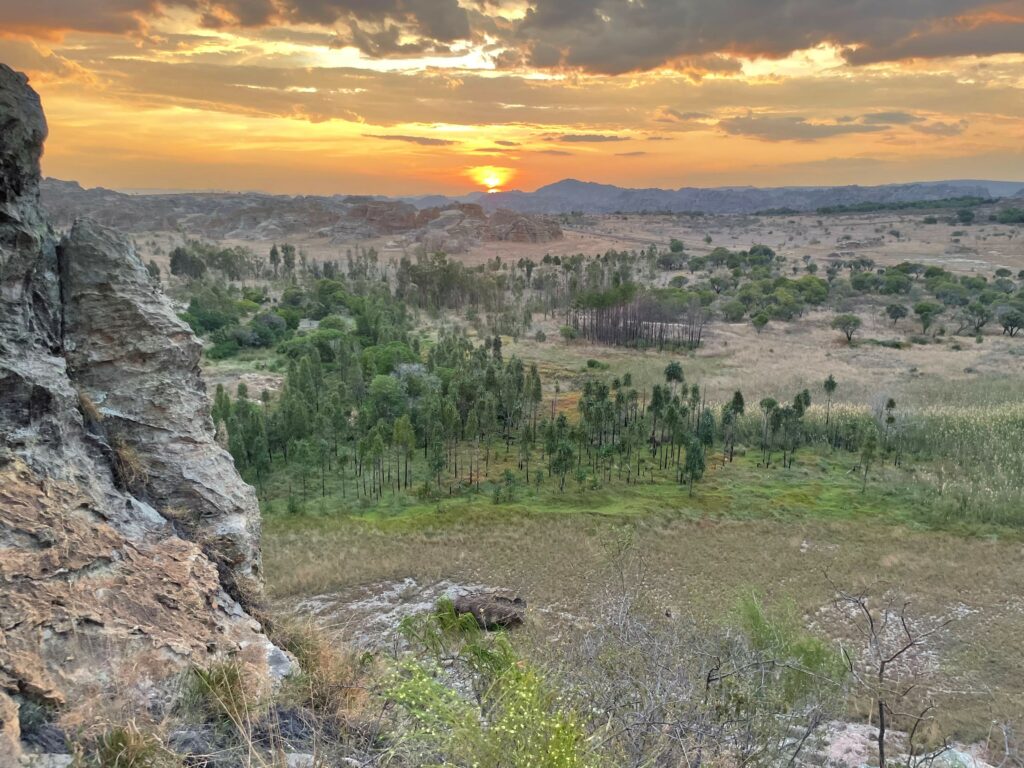
Sunset at Isalo
Digging usually begins at sunrise, when the temperature is at its coolest. Unfortunately, with a three-hour journey ahead of us and unable to travel in darkness, we didn’t have that luxury. By the time we arrived, the team had already finished digging and moved on to sieving at the river; a task slightly more bearable in the heat, though there was no shade. Undeterred, I was joined by one of our mining supervisors and we got stuck into digging.
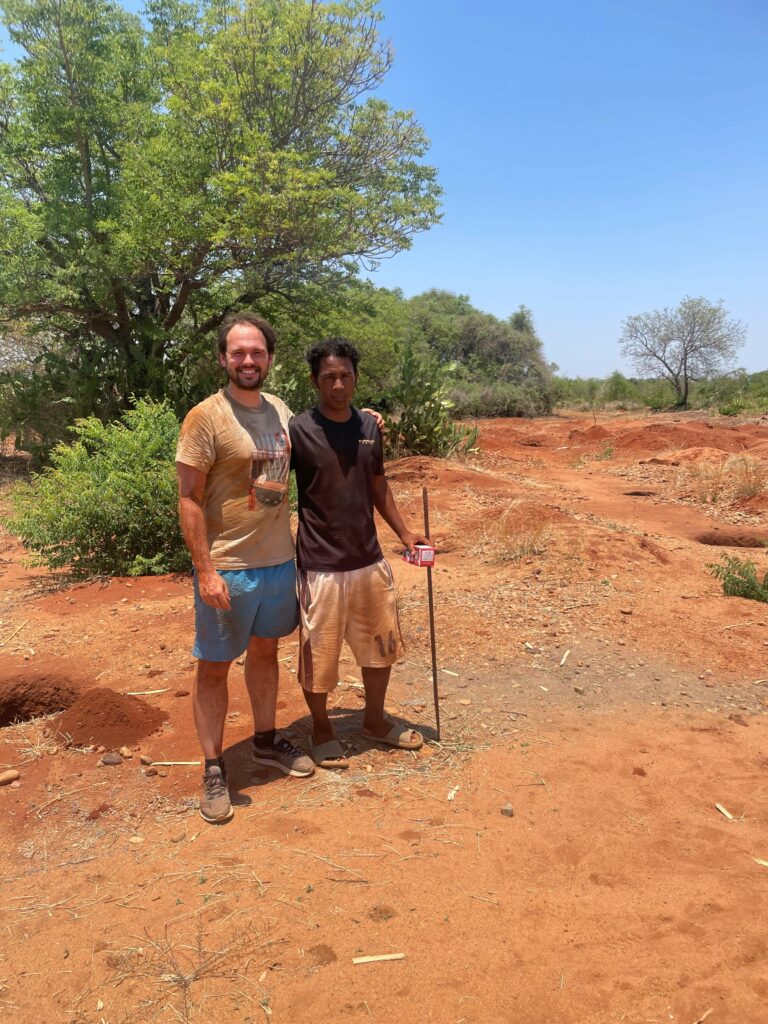
Dirty and sweaty after digging with Manmy
The heat was relentless, soaring to 40 degrees, and the work was gruelling. The gravel had to be loosened, scraped out, and packed into sacks, which we stacked up outside the ‘jaguar’. As the sweat poured and the dust clung to my skin, I learned that during this part of the day, the team had no access to water, only drinking once they reached the river. Parched and exhausted, I resolved to change this practice, having experienced first-hand just how punishing it was to work in such conditions.
Once we had filled a good number of sacks with gravel, the truck arrived, and we loaded them up. The river provided a welcome change after the sweat and mud of digging. As I waded in carrying my toil, I was met with a mix of shock and excitement from the miners; seeing a foreigner digging alongside them was clearly unexpected. The workforce here is quite hierarchical, and management rarely gets their hands dirty. I took great pleasure in upsetting this paradigm.
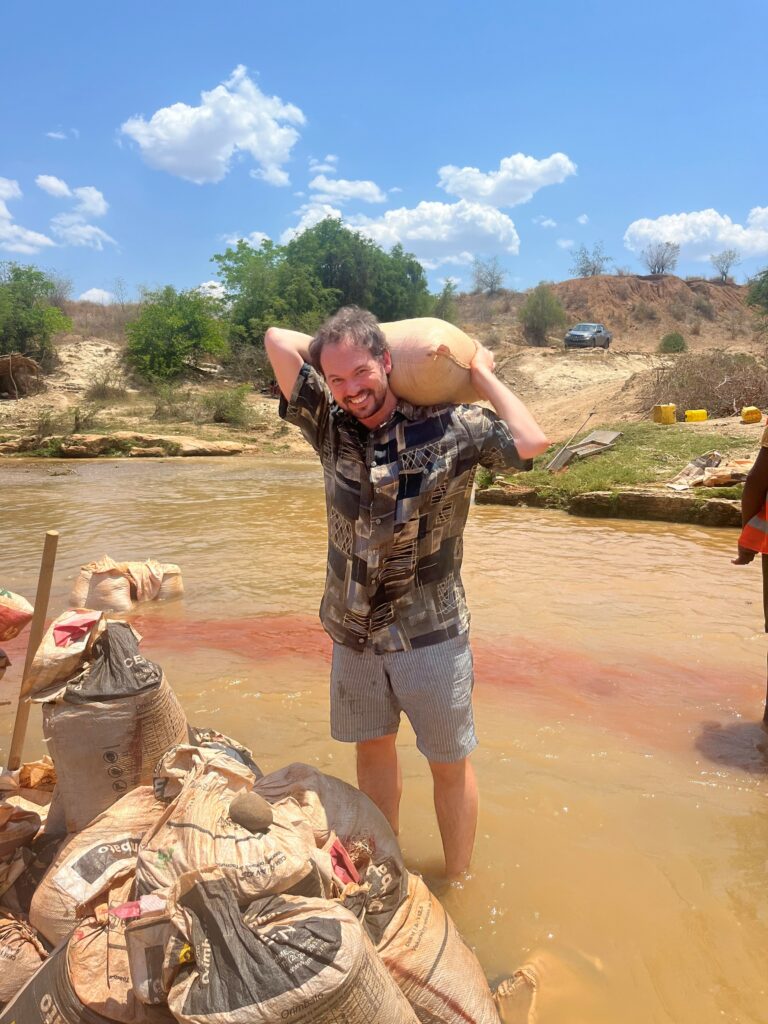
Shifting sacks of gravel to the river
Unfortunately, there wasn’t a sieving tray available, so I had to wait until one was found for me. I took this time to sit at the edge of the river. Children were playing in the water whilst their parents worked, food was cooking, and it was so peaceful with the warm water and sounds of nature. I contemplated that whilst the lives of the people here are full of hardships, they possess a remarkable resilience and sense of community. The simplicity of their joys; children laughing as they splashed, the scent of freshly cooked food mingling with the soft, fleeting impressions of the riverbanks. It truly felt like a different world from the structured chaos I knew back home.
When a tray was finally found, I got straight into it. The sieving trays were chunky contraptions of wood and metal, surprisingly heavy even before being loaded with gravel. Sieving required a specific technique, and teams typically worked in pairs. One loading and the other sieving, both scanning intently for the glint of colour that might signal a gemstone. I was amazed at how quickly the miners worked, methodically sifting through the material. In contrast, I lagged far behind, moving slowly and carefully, worried I might miss something.
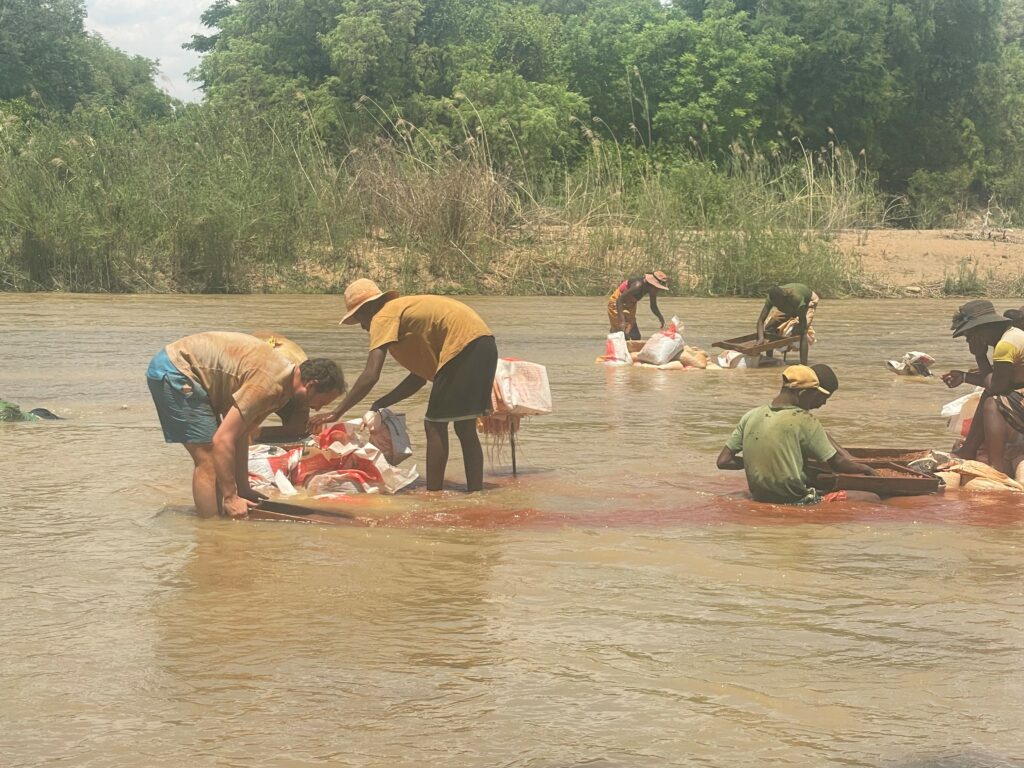
Sieving in the river
It didn’t take long for me to realize just how backbreaking this work was. The miners endured it for hours, day after day, in the relentless heat. Out in the open under the blazing sun, my skin was beginning to burn, and I reluctantly decided to take a break. Despite my efforts, I hadn’t found anything, and it seemed like the right time to stop for lunch.
After lunch, I was eager to return to the sieving, but time was running short. We had another meeting to attend, this time with the full mining team, before heading back to the village for a final meeting with the father. The team meeting turned out to be an enlightening and uplifting experience. Each member shared a little about themselves, their hopes and dreams, and their thoughts on the project. A common theme emerged: they all yearned for stability in their lives and the ability to support their families and friends.
The gratitude they expressed for the opportunity to work on the project was deeply moving. Their belief in the vision and their loyalty to our mining manager, earned through his steady leadership during difficult times, was particularly inspiring. This open and honest exchange left me feeling both encouraged but with a renewed sense of responsibility. So many people were pinning their hopes and lives on this. I had understood this before, but sitting and discussing it directly with the team made it so much more real.
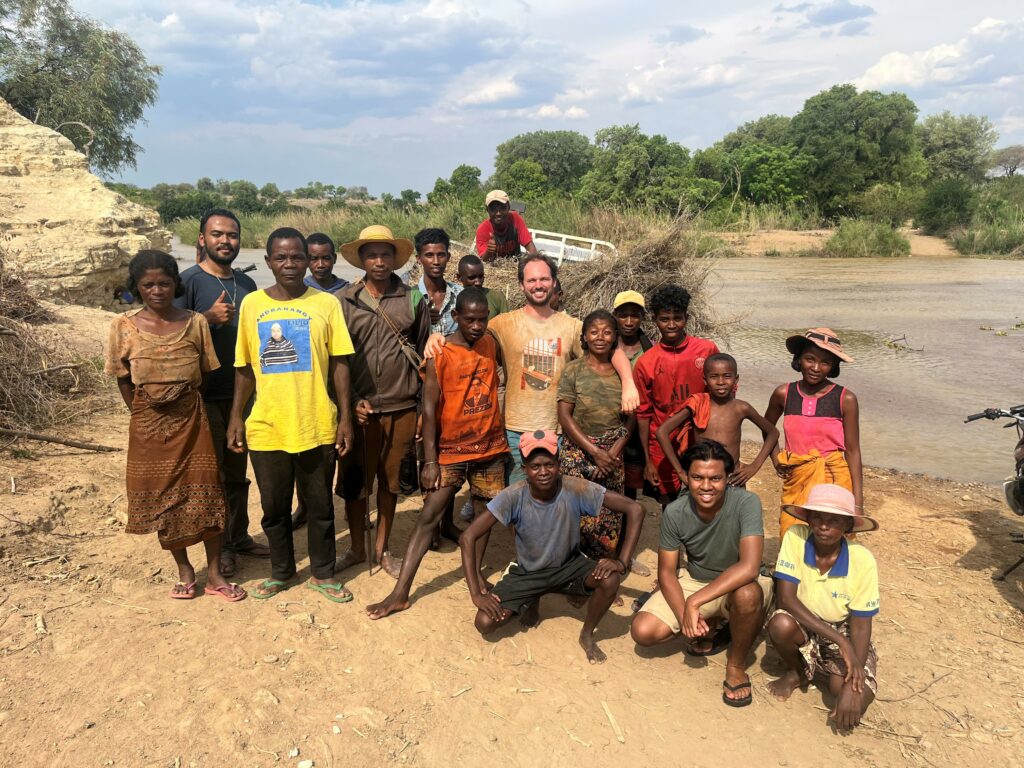
Some of the team (along with other villagers!)
We returned to the village for the final meeting with the father, which was conducted without my presence and went on for quite some time. I waited in the car, observing life in the village. The original truck was parked up nearby and underneath it was a menagerie of dogs, ducks and chickens seeking refuge from the heat of the day. When the meeting was over, I was informed that the father had decided to leave the village within the week, and without any requirement for us to purchase his remaining stones. He planned to retire from mining and return to his family. This result was a great relief to all of us, but as we prepared to leave we got caught up in the return of the mining team, protracting our departure.
As everyone was making their farewells, the father came to me. I could see the barely held back emotions quivering underneath his earnest expression. This was a man grappling with his legacy. His last try for glory a torch sputtering and flickering, on the verge of extinction, and him reluctant to pass it on. As he shook my hand, he thanked me for my trust and belief, apologising for the difficulties he had caused. In return I promised him I would look after and support his son.
In this moment his gratitude and hope for his son broke through. I could see him as more than the disruptor he became, but as a man with a passion for life undiminished by time. His conflict with his son a symptom of his battle against redundancy and mortality. I wondered how many old miners had spent their lives hoping for that one stone that would change everything, only to find themselves used up and cast aside. Their dreams just a memory down some long-abandoned hole in the desert. I was more resolute than ever to break this cycle and help build something enduring.
Though we left the mining site without any significant stones, we departed with a sense of accomplishment, having greatly improved relations and secured a more stable foundation for the future. The workers were buzzing with excitement and a renewed sense of hope and purpose, as was I.
The next day we endured another fifteen hours in the car to return to Antsirabe, home of our lapidary workshop. This region is also renowned for its pegmatites, which produce tourmaline, beryl, and a variety of other interesting minerals. We had been in contact with a team in the hills outside the city who were engaged in a promising dig, and the plan was to get out there the following day.
Alistair McCallum FGA
+44(0)20 7405 2169

Marcus McCallum Ltd
Second Floor
62 Hatton Garden
London EC1N 8LR
info@marcusmccallum.com
